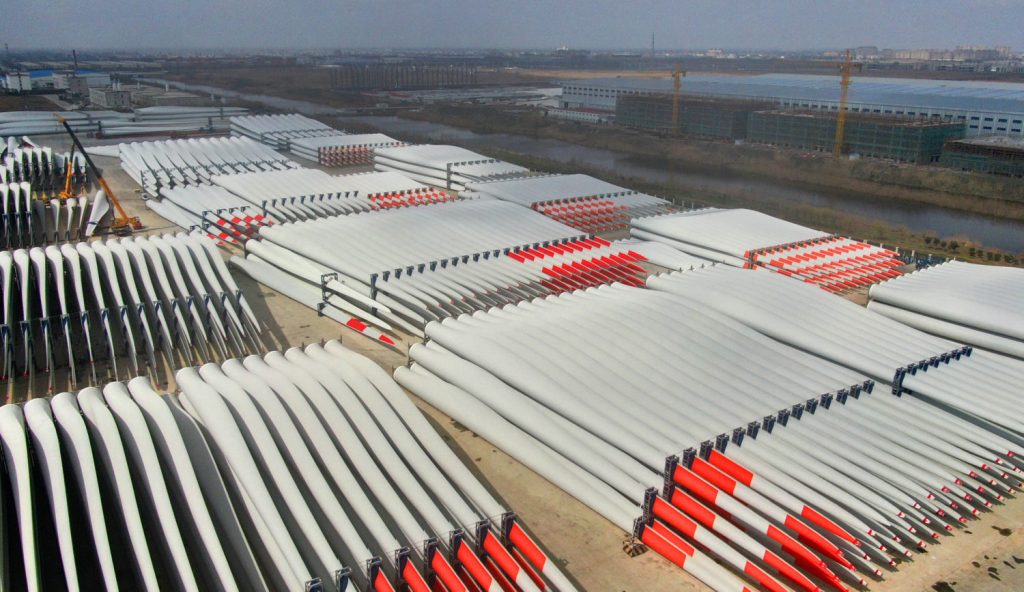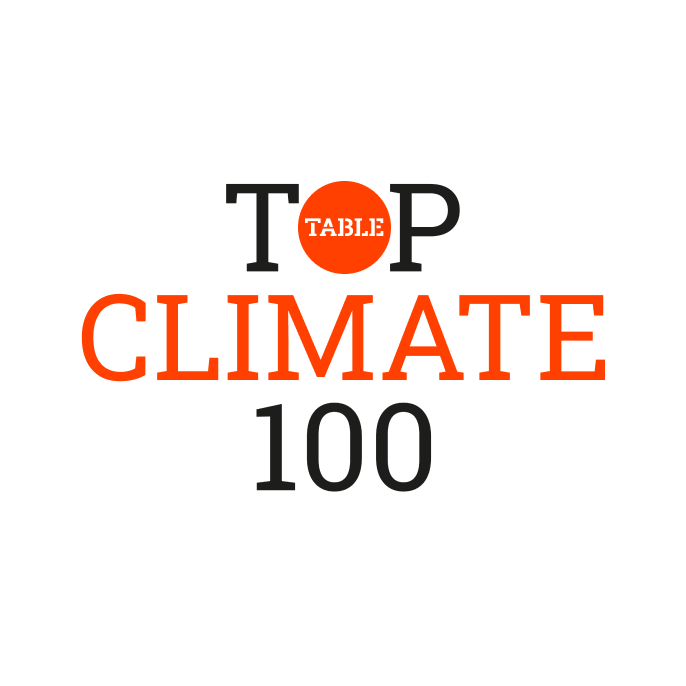Today, we’re doing what we love most: delving into topics that don’t always take center stage but are nonetheless highly relevant. For instance, during Economy Minister Habeck’s trip to China, everyone talked about the trade conflict between the EU and China over electric vehicles and solar technology. However, Nico Beckert analyzes the previously overlooked risk of such a dispute affecting the wind power industry.
The topic of the “voluntary carbon market” often flies under the radar as well, mainly because it’s abstract and quite complex. That’s why we’ve included an article by Tin Fischer, explaining the US government’s proposals to regulate this market, along with the criticism that it could quickly lead to greenwashing. Additionally, our Europe specialist, Lukas Scheid, writes about another often ignored (budgetary) risk: Since Germany (and other countries like Italy) are failing to meet their European CO2 targets, especially in transportation, future finance ministers could face significant costs. According to a study, this could amount to 16 billion euros by 2030.


Over the weekend, the trade dispute between Europe and China showed initial signs of easing. During Economy Minister Robert Habeck’s trip to China, the EU and China agreed to new talks regarding the EU’s protective tariffs on electric vehicle imports from China. This development is considered a success for Habeck.
However, current developments in the wind industry could lead to new trade conflicts in the future. China has built massive production capacities in the wind sector, bolstered domestic companies with subsidies and shielded them from foreign competition. The industry is increasingly targeting the global market, threatening to take market share from Western manufacturers. Increased competition and lower prices would benefit the energy transition in developing and emerging countries but could further squeeze the profits of Western manufacturers.
The global wind energy market is currently quite segmented: Western manufacturers dominate in the West, while domestic manufacturers hold an almost monopoly in China. Due to the large domestic market, four of the five largest manufacturers worldwide are from China. “Chinese wind turbine manufacturers are massively expanding and trying to push their overcapacity onto international markets,” says a spokesperson for Wind Europe, the European wind energy association, to Table.Briefings.
This expansion involves some unusual alliances: “Well-funded Chinese and Arab energy companies are now building massive wind power capacities with Chinese-made turbines across developing countries,” write analysts from the consulting firm Trivium China.
Many Chinese suppliers are expanding abroad, setting up production facilities or planning to do so:
So far, China has not made significant inroads into the European and US markets. However, “in their expansion, Chinese wind turbine manufacturers are also trying to gain a foothold in the European market,” observes Wind Europe. The association cautions: The dependence on Russian gas should “definitely not be repeated with clean tech from China. The production of wind turbines in Europe is also a matter of our energy security – and ultimately our national security.”
Chinese wind turbine manufacturers have significant advantages in the global market:
These cost advantages make wind power increasingly attractive for emerging and developing countries. The growing presence of Chinese suppliers “on global markets has the potential to significantly reduce the costs of wind turbines worldwide,” say Trivium China analysts.
China’s wind turbine manufacturers owe their competitive advantages to the country’s industrial and trade policies. While Western manufacturers had a 70 percent market share in China in the 2000s, they have been nearly completely displaced by subsidies for domestic producers and requirements to use locally made goods. Today, Chinese manufacturers share 99.8 percent of the domestic market.
High demand has allowed Chinese manufacturers to achieve cost-effective mass production with significant economies of scale. Additionally, Chinese manufacturers have caught up with and surpassed Western manufacturers in the size of their turbines in recent years. In the offshore sector, the first turbines with a capacity of 18 megawatts (MW) are being installed, while the 10-MW mark has been surpassed onshore. Larger turbines allow for more wind power to be installed on less land, requiring fewer turbines to equip a wind farm with a certain capacity, resulting in cost and time savings.
However, there are also overcapacities in the Chinese wind energy market, leading to a “brutal price war”, according to Trivium China analysts. The race for the largest wind turbines “could prove to be unsustainable“, say analysts from the energy consulting firm Wood Mackenzie. While Chinese manufacturers are still profitable, “declining prices could lead to a profit crisis for Chinese wind companies,” according to Wood Mackenzie analysts. This is another reason for them to target the global market.
Western manufacturers have been in a profit crisis for some time. “Supply chain disruptions, rising raw material prices, geopolitical tensions, and quality issues” have affected Western manufacturers. Their production capacities are insufficient to meet rising global demand. Due to low profitability, investments in new factories are challenging. Chinese manufacturers see this as a “unique opportunity” to gain global market share. They can leverage their financial power and the massive size of their domestic supply chain to challenge Western manufacturers in developing and emerging markets, according to Wood Mackenzie experts.
However, it is unlikely that China will achieve dominance in the wind sector similar to that in photovoltaics. Logistics are more complicated with bulky wind turbines, and turbines require on-site maintenance. “European manufacturers have established high-quality service and maintenance structures over the years. Chinese manufacturers have not yet built these structures or earned customer trust,” says the German Wind Energy Association (BWE) to Table.Briefings.

The US government aims to advance climate action through voluntary measures to offset CO2 emissions. In a new concept paper, it has outlined its expectations and goals for overhauling the Voluntary Carbon Market (VCM). Meanwhile, major US companies like Amazon, Microsoft, Google and Meta are launching new projects for compensation certificates. However, criticism of voluntary CO2 offsets remains persistent, as demonstrated by the difficulties faced by Switzerland in achieving many of its compensation goals.
The new paper from the White House outlines on twelve pages the principles by which the voluntary compensation market should operate:
The voluntary compensation market has experienced both a boom and a crash. After studies and reports on worthless certificates, the market collapsed in 2023. In a new attempt, industry initiatives and rating agencies promise to define and control quality standards. Additionally, the emissions trading between states through Article 6.2 of the Paris Agreement is gaining momentum, driven by countries like Switzerland, Singapore and South Korea.
John Kerry, during his tenure as the US President’s Special Climate Envoy, stated: “We need serious carbon markets to drive climate ambitions.” He emphasized that only the private sector has the funds to meet climate goals. “If we do not mobilize the private sector, we will not win this fight. It’s that simple,” Kerry warned.
The US approach differs significantly from Europe’s. “The opportunities and risks of voluntary compensation are viewed very differently in the US compared to Europe. There is much greater hope in the voluntary market,” says Lambert Schneider from the Berlin-based Öko-Institut. The US lacks instruments like the EU’s mandatory market in emissions trading.
The US proposals focus on familiar areas: certificates for renewable energy in developing and emerging countries and forest conservation. The Energy Transition Accelerator, an initiative involving the State Department and Jeff Bezos’s foundation, as well as the LEAF Coalition, involving the US, the UK and Amazon, aim to generate credits in the next ten years “equivalent to more than two billion tons of greenhouse gas reductions,” according to Kerry. This would be twenty times the current annual volume of around 100 million tons. The initiative, introduced at COP27 in 2022, has drawn criticism for its regulations that contradict the recommendations of a UN expert group aimed at preventing greenwashing.
Accordingly, there has been a lot of movement in recent weeks, particularly in the forest conservation market. Google, Meta, Salesforce and Microsoft, for example, announced their intention to generate 20 million certificates from tree planting projects that are intended to restore nature. The companies have founded an initiative called Symbiosis, whose rules also allow CO2 credits from timber plantations. However, these plantations are often criticized because they are not additional – in other words, the plantations would have been established even without money from certificates.
The LEAF Coalition, primarily driven by Amazon, aims to generate millions of credits through forest conservation in the Global South, promising at least 10 dollars per ton, significantly higher than the current market price. The new ART TREES standard will transform entire countries or regions into compensation projects. Historically, forest conservation projects had to show that a forest would have been cleared without their protection. ART TREES, however, will also reward countries with carbon credits that have not experienced significant deforestation or where deforestation has already declined. Guyana, a pioneer in this approach, has already generated 40 million credits.
Schneider criticizes this approach, stating, “From our perspective, they are generating hot air.” Countries can retroactively enroll in ART TREES if their deforestation has decreased for any reason, such as a decline in palm oil exports. Carbon Market Watch is also critical, with Isa Mulder of the NGO noting, “Some say they just look at their forests and turn them into credits. We should reward countries like Guyana for their forests, but not in this way. It doesn’t offset anything.”
Will US companies voluntarily purchase such credits if faced with greenwashing accusations? Last year, buyers became not only fewer but also more selective, as an analysis by the rating agency Calyx shows. Instead of forest conservation credits, stove projects are now more commonly purchased, as they are slightly better rated. The criticism in the market has created a “collective pressure to improve the integrity of carbon credits,” according to Calyx.
To ensure quality, industry initiatives like the Integrity Council for the Voluntary Carbon Market (ICVCM) are tasked with defining what constitutes “high integrity carbon credits“. The first seven rulebooks – for credits from landfills – have recently received the ICVCM stamp of approval. The evaluation of forest conservation credits will follow in the coming months.
“The Americans are ultimately trying to square the circle,” Schneider remarks. They want large quantities of credits that also meet high standards. Switzerland, which aims to offset part of its road traffic emissions abroad, currently exemplifies the challenges in meeting such standards. Switzerland needs 20 million tons in the coming years but maintains high-quality standards (excluding forest certificates). The KliK Foundation, responsible for this task, calls the goal “not impossible” in its new annual report but cautions that “it cannot be assumed that the contractually promised amount of certificates will be delivered”.
Without immediate measures, twelve EU countries are projected to miss their national climate targets under the ESR, according to a study by the transport and environmental organization Transport & Environment (T&E). T&E analyzed the draft national energy and climate plans to reach this conclusion.
The ESR allocates allowed emission amounts to each member state for sectors outside the EU Emissions Trading System (ETS), including road transport, buildings, small industries, waste and agriculture. Countries that fail to meet their ESR targets must purchase excess certificates from other countries. According to T&E, Germany could owe up to 16.2 billion euros due to shortfalls in the transport sector.
Data from the German Environment Agency (UBA) indicates that Germany will emit 126 million tons of CO2 equivalents above its ESR allocation. T&E bases its calculations on a certificate price of 129 euros, as projected by Bloomberg for the ETS sectors in 2030. The UBA estimates a price of 125 euros per ton of CO2.
Higher prices are primarily due to the scarcity of certificates. Germany alone would consume about 70 percent of the excess certificates available from other EU countries, given the 126 million ton shortfall forecasted by T&E. T&E warns that without immediate action, there will be a significant shortage of credits, as multiple countries are expected to miss their targets.
Italy is expected to require an additional 120 million emission credits under the ESR, potentially costing Rome up to 15.5 billion euros. Together, Germany and Italy would need 246 million certificates. However, only 180 million excess certificates are likely to be available from other member states. This means that ten other countries failing to meet their ESR targets would have no means to comply, leading to high costs for taxpayers in Germany and Italy.
Sebastian Bock, managing director of T&E Germany, criticizes the German government’s amendment to the climate change law, which abolished sector-specific targets, calling it a “sleight of hand”. He states, “Volker Wissing faces a clear choice: either pay billions to our European neighbors for delayed climate action or finally take climate protection in the transport sector seriously.” luk
Two-thirds of people worldwide favor higher, progressive taxation of wealthy individuals and environmentally harmful companies. This support is similarly high among higher-income individuals in many countries. In Germany, approximately 71 percent of the general population supports higher income taxes for the rich and 68 percent support higher wealth taxes. These findings come from a representative survey conducted in 22 countries, including 18 G20 countries such as Germany, France, the USA, Brazil, China, India and Austria, commissioned by Earth4All and the Global Commons Alliance.
Support for wealth taxes is particularly high in Germany, says Owen Gaffney, head of Earth4All and former analyst at PIK. This highlights the “strong support for economic justice in Germany“. Therefore, the German government needs to make its tax policy fairer and more sustainable.
The debate over higher taxes for the rich is gaining traction in international climate policy. The wealthiest 1 percent currently cause 16 percent of emissions and the richest 10 percent are responsible for 50 percent. In April, Development Minister Svenja Schulze (SPD) joined finance ministers from Spain, South Africa and Brazil in calling for a global billionaire tax. Brazil currently holds the G20 presidency. From July 25 to 26, finance ministers will meet there, and for the first time, wealth taxes will be on the agenda. lb
Late last week, young activists in Hawaii reached a significant settlement following a climate lawsuit, requiring the local transportation department to reduce emissions and engage with young people on climate impacts. According to the Washington Post, this settlement is the first of its kind globally, where young people successfully sued over transportation emissions.
Under the settlement, Hawaii must present an emission reduction plan within a year, with interim targets every five years. The transportation sector must be fully decarbonized within 20 years. The plan aims to strengthen transportation options for cyclists, public transit users, and pedestrians, as well as expand infrastructure for electric vehicles.
In the lawsuit filed in 2022, the young plaintiffs argued that Hawaii’s transportation system violated their right to a “clean and healthy environment”. The youngest plaintiff was nine years old at the time. The lawsuit was supported by the organizations Our Children’s Trust and Earthjustice. The settlement was announced just before the case was set to go to trial. kul
According to official reports, 1,301 people died from extreme heat during the Muslim pilgrimage Hajj in Saudi Arabia. The majority of the deceased were unregistered pilgrims, as stated by Saudi Health Minister Fahad Al-Jalajel on Sunday evening. “The unregistered pilgrims walked long distances under the sun without protection or rest. Some were elderly and others had chronic illnesses,” the health minister explained. This year, approximately 1.8 million pilgrims participated in the Hajj. A rapid analysis by Climameter attributes the extreme temperatures during the heatwave to human-induced climate change.
Currently, many other countries and regions are experiencing heatwaves:
In a commentary for the journal One Earth, energy economist Claudia Kemfert from the German Institute for Economic Research (DIW) and Jan Rosenow from the NGO Regulatory Assistance Project (RAP) have outlined five strategies for managing the reduction of gas networks as the use of natural gas in Europe decreases. According to their projections, the demand for natural gas will decline by up to 70 percent by 2050. Without accompanying political measures, network charges in Germany could quintuple in the next 16 years.
Kemfert and Rosenow propose five policy measures to prepare gas networks for the decreasing demand:
There is currently no plan for the dismantling of existing networks. “It is essential to start writing off the gas network and organizing the phased shutdown early to avoid stranded assets and significant cost increases for remaining customers,” says Claudia Kemfert from the DIW. In Germany, there are over 511,000 kilometers of gas transport pipelines that could become stranded assets according to the researchers. seh
Siemens Energy has been awarded a 1.4 billion euros contract from Saudi Arabia to construct two large gas and steam turbine power plants. These plants, Taiba 2 and Qassim 2, are expected to deliver nearly four gigawatts of electricity and are touted by Siemens Energy as the “world’s largest, most advanced and efficient gas and steam turbine power plants”.
The facilities are intended to partially replace heavy oil-fired power plants and achieve up to 60 percent CO2 savings. Siemens Energy also disclosed that the contract includes a 25-year maintenance agreement. The China Energy International Group serves as the contracting partner and general contractor for the project. Additionally, Saudi Arabia plans to build CCS (carbon capture and storage) facilities in the medium term to enable a climate-neutral energy supply.
According to the Climate Action Tracker, Saudi Arabia’s climate policy is deemed “critically insufficient”. The country has yet to implement measures to reduce its fossil fuel dependency. In its Nationally Determined Contribution (NDC), Saudi Arabia aims to produce 50 percent of its electricity from renewables by 2030. However, as of 2020, only 0.3 percent of its electricity was generated from renewable sources. The country aims to achieve net-zero emissions by 2060. dpa/kul
The recent study, published in Nature Climate Change, suggests that the time women spend collecting water could increase by up to 30 percent due to higher temperatures altering rainfall patterns, resulting in less available water and fewer water sources. Additionally, the journey to water sources becomes more arduous due to heat stress, lengthening the time needed for water collection.
In regions of South America and Southeast Asia, the time spent on water collection could even double by 2050 as a consequence of higher temperatures. This extended effort not only impacts women’s time but also reduces their availability for other activities. According to PIK’s calculations under high-emission scenarios, costs could reach up to hundreds of millions of US dollars per country annually.
Approximately two billion people worldwide lack direct access to clean drinking water, a responsibility often falling on women. The study highlights a gender-specific dimension of climate change impacts, illustrating how significantly climate change will affect women’s well-being. “The results show how much climate change will affect the well-being of women. Longer water collection times reduce their time for education, work and leisure,” says Leonie Wenz, co-author and PIK researcher. The increase in water collection time could be reduced by 19 percent if global warming is kept below two degrees Celsius. seh
By 2030, at least 10 trillion dollars in new insurance coverage will be needed in energy, transportation and construction sectors – particularly for large infrastructure projects such as offshore wind farms, solar parks and building insulation. This conclusion comes from a recent report by insurance broker Howden and the Boston Consulting Group, as reported by the Financial Times.
According to the report, 19 billion dollars in investments worldwide have been pledged for the energy transition. Insurance coverage will be crucial for over half of these investments, putting the industry under “unprecedented structural pressure”. While many insurers already provide additional protection for hydrogen-powered and electric vehicles, offshore wind turbines or hybrid building materials, they are also planning to expand coverage to newer technologies.
However, insurance companies must weigh the risks involved in areas where data on potential losses is lacking. The pressure is further compounded by natural disasters becoming more severe under climate change, leading to infrastructure destruction. Additionally, there is unlikely to be additional capacity for green projects by 2030, as insurance support for fossil projects is expected to decrease only slightly. asc


Johan Rockström – Director, Potsdam Institute for Climate Impact Research (PIK); Professor of Earth System Sciences, University of Potsdam
Johan Rockström was deservedly awarded this year’s “Tyler Prize for Environmental Achievement”, often dubbed the “Nobel Prize for Environment”. The Swede is one of the most influential thinkers and advisors in international climate and sustainability policy. Formerly head of the Stockholm Environment Institute, Rockström has co-directed PIK with climate economist Ottmar Edenhofer since 2018. His 2009 concept of “planetary boundaries” has had significant impact, describing Earth’s system stresses and warning of climate and nature system tipping points. Rockström regularly delivers science-based admonishments to politicians and business leaders at forums like the World Economic Forum in Davos and COP conferences.

Christiane Textor – Head, German IPCC Coordination Office
Christiane Textor occupies a key role at the intersection of science and policy on climate change in Germany. As head of the IPCC Coordination Office, the atmospheric scientist participates intensively in technical negotiations of the IPCC and serves as a liaison for media and the public. She has represented Germany in IPCC processes for years and is well-versed in the comprehensive IPCC reports. Textor also advises the Federal Foreign Office and the Federal Ministry of Research, bridging scientific and political expertise. As a member of the German delegation at climate negotiations, she aligns German and European positions, such as for the Global Stocktake, and brings them to the negotiation table.

Roda Verheyen – Partner, Rechtsanwälte Günther
Roda Verheyen became a lawyer to effectively advocate for the environment. She is known for two climate lawsuits: one ongoing case demanding RWE financially contribute to climate change costs in Peru, and another, alongside other constitutional complaints, that led to the German Federal Constitutional Court’s climate ruling in 2021. Currently, Verheyen is suing, along with Greenpeace, against the EU Commission’s decision to classify gas and nuclear power as sustainable. She is a partner at the Hamburg-based environmental law firm Günther, a volunteer judge at the Hamburg Constitutional Court, co-founder of the international “Climate Justice Programme” network, and board member of Green Legal Impact Germany.

Remo Klinger – Partner, Geulen & Klinger
Remo Klinger is the legal mastermind behind the climate lawsuits of the Environmental Action Germany (DUH). He has won diesel driving bans in court and was involved in two of the four constitutional complaints leading to the groundbreaking climate ruling by the German Federal Constitutional Court in 2021. Since then, Klinger has won further cases with DUH for more ambitious German climate policies. He is a partner at the Berlin-based law firm Geulen & Klinger, specializing in public law, an honorary professor at the University of Sustainable Development Eberswalde, co-editor and editorial board member of the Journal for Environmental Law and member of the legislative committee for environmental law of the German Bar Association.

Wolfgang Blau – Managing Partner, Climate Hub, Brunswick
Wolfgang Blau is a climate communicator through and through: For years, the publicist has advocated for better climate journalism – specifically, for the climate crisis to receive the attention it deserves across all departments and topics. Every story is a climate story, according to Blau. At the consulting firm Brunswick, Blau helps companies prepare for the impacts of global warming. In 2021, he co-founded the Climate Journalism Network at the University of Oxford. He previously held leadership positions at Condé Nast and The Guardian and was editor-in-chief of Zeit Online.

Cory Combs – Deputy Director, Trivium China
As an analyst at the consulting firm Trivium China, Cory Combs is one of the most knowledgeable experts on China’s climate and energy policies. He produces the Trivium China Net Zero newsletter, providing updates on new regulations, legislative plans and the economic challenges of China’s energy transition. Combs focuses on the energy transition, decarbonizing China’s industry, and raw material issues. He advises companies, investors, and policymakers on regulatory changes and political developments in China.

Katharine Hayhoe – Professor, Texas Tech University
Katharine Hayhoe is a leading climate change communicator. The Canadian frequently confronts climate change deniers, including many believers and politicians in the US who challenge her research. The climate scientist and evangelical Christian persists, speaking out against myths about the climate crisis on TV and in TED Talks, advocating for the compatibility of faith and science. In 2021, Hayhoe joined the conservation organization Nature Conservancy as a lead scientist.

Jim Skea – Chairman, IPCC
The Scot has been the head of the Intergovernmental Panel on Climate Change (IPCC), the foremost scientific body for international climate negotiations, since July 2023. He leads the 7th assessment cycle of the IPCC and will hold the chair until the 7th assessment report. Skea’s voice carries significant weight, which even COP presidents utilize. When Sultan Al Jaber faced accusations of being anti-science, he sat alongside Skea at a press conference in Dubai to have his statements personally verified by the IPCC chief.

Frank Peter – Director, Agora Industry
As director of Agora Industry, Frank Peter is a key advisor to the German government on industrial transformation. His work focuses on restructuring the steel, cement and chemical industries, scaling up the hydrogen economy and political measures like climate protection contracts, the carbon management strategy and measures to reduce industrial electricity prices. Peter coordinates the 30-member industry team of the think tank. Before joining Agora, he spent twelve years at the economic research company Prognos.

Claudie Kemfert – Head of Department Energy, Transport and Environment German Institute for Economic Research (DIW)
Claudia Kemfert heads the Energy, Transport and Environment Department at the German Institute for Economic Research (DIW) and is a professor of energy economics and energy policy at Leuphana University Lüneburg. The German economist and author has been co-chair of the Council of Environmental Advisors (SRU) since 2016 and serves as an expert and policy advisor. In Brussels, she has advised former EU Commission President José Manuel Barroso. For MDR, she discusses climate and energy topics every two weeks in “Kemfert’s Climate Podcast”. She faces defamation campaigns and harassment, a growing issue for climate researchers who take a public stance. Kemfert lives in Oldenburg and Berlin, is married, and was born in 1968 in Delmenhorst, which is also the title of her favorite song by Element of Crime.
Today, we’re doing what we love most: delving into topics that don’t always take center stage but are nonetheless highly relevant. For instance, during Economy Minister Habeck’s trip to China, everyone talked about the trade conflict between the EU and China over electric vehicles and solar technology. However, Nico Beckert analyzes the previously overlooked risk of such a dispute affecting the wind power industry.
The topic of the “voluntary carbon market” often flies under the radar as well, mainly because it’s abstract and quite complex. That’s why we’ve included an article by Tin Fischer, explaining the US government’s proposals to regulate this market, along with the criticism that it could quickly lead to greenwashing. Additionally, our Europe specialist, Lukas Scheid, writes about another often ignored (budgetary) risk: Since Germany (and other countries like Italy) are failing to meet their European CO2 targets, especially in transportation, future finance ministers could face significant costs. According to a study, this could amount to 16 billion euros by 2030.


Over the weekend, the trade dispute between Europe and China showed initial signs of easing. During Economy Minister Robert Habeck’s trip to China, the EU and China agreed to new talks regarding the EU’s protective tariffs on electric vehicle imports from China. This development is considered a success for Habeck.
However, current developments in the wind industry could lead to new trade conflicts in the future. China has built massive production capacities in the wind sector, bolstered domestic companies with subsidies and shielded them from foreign competition. The industry is increasingly targeting the global market, threatening to take market share from Western manufacturers. Increased competition and lower prices would benefit the energy transition in developing and emerging countries but could further squeeze the profits of Western manufacturers.
The global wind energy market is currently quite segmented: Western manufacturers dominate in the West, while domestic manufacturers hold an almost monopoly in China. Due to the large domestic market, four of the five largest manufacturers worldwide are from China. “Chinese wind turbine manufacturers are massively expanding and trying to push their overcapacity onto international markets,” says a spokesperson for Wind Europe, the European wind energy association, to Table.Briefings.
This expansion involves some unusual alliances: “Well-funded Chinese and Arab energy companies are now building massive wind power capacities with Chinese-made turbines across developing countries,” write analysts from the consulting firm Trivium China.
Many Chinese suppliers are expanding abroad, setting up production facilities or planning to do so:
So far, China has not made significant inroads into the European and US markets. However, “in their expansion, Chinese wind turbine manufacturers are also trying to gain a foothold in the European market,” observes Wind Europe. The association cautions: The dependence on Russian gas should “definitely not be repeated with clean tech from China. The production of wind turbines in Europe is also a matter of our energy security – and ultimately our national security.”
Chinese wind turbine manufacturers have significant advantages in the global market:
These cost advantages make wind power increasingly attractive for emerging and developing countries. The growing presence of Chinese suppliers “on global markets has the potential to significantly reduce the costs of wind turbines worldwide,” say Trivium China analysts.
China’s wind turbine manufacturers owe their competitive advantages to the country’s industrial and trade policies. While Western manufacturers had a 70 percent market share in China in the 2000s, they have been nearly completely displaced by subsidies for domestic producers and requirements to use locally made goods. Today, Chinese manufacturers share 99.8 percent of the domestic market.
High demand has allowed Chinese manufacturers to achieve cost-effective mass production with significant economies of scale. Additionally, Chinese manufacturers have caught up with and surpassed Western manufacturers in the size of their turbines in recent years. In the offshore sector, the first turbines with a capacity of 18 megawatts (MW) are being installed, while the 10-MW mark has been surpassed onshore. Larger turbines allow for more wind power to be installed on less land, requiring fewer turbines to equip a wind farm with a certain capacity, resulting in cost and time savings.
However, there are also overcapacities in the Chinese wind energy market, leading to a “brutal price war”, according to Trivium China analysts. The race for the largest wind turbines “could prove to be unsustainable“, say analysts from the energy consulting firm Wood Mackenzie. While Chinese manufacturers are still profitable, “declining prices could lead to a profit crisis for Chinese wind companies,” according to Wood Mackenzie analysts. This is another reason for them to target the global market.
Western manufacturers have been in a profit crisis for some time. “Supply chain disruptions, rising raw material prices, geopolitical tensions, and quality issues” have affected Western manufacturers. Their production capacities are insufficient to meet rising global demand. Due to low profitability, investments in new factories are challenging. Chinese manufacturers see this as a “unique opportunity” to gain global market share. They can leverage their financial power and the massive size of their domestic supply chain to challenge Western manufacturers in developing and emerging markets, according to Wood Mackenzie experts.
However, it is unlikely that China will achieve dominance in the wind sector similar to that in photovoltaics. Logistics are more complicated with bulky wind turbines, and turbines require on-site maintenance. “European manufacturers have established high-quality service and maintenance structures over the years. Chinese manufacturers have not yet built these structures or earned customer trust,” says the German Wind Energy Association (BWE) to Table.Briefings.

The US government aims to advance climate action through voluntary measures to offset CO2 emissions. In a new concept paper, it has outlined its expectations and goals for overhauling the Voluntary Carbon Market (VCM). Meanwhile, major US companies like Amazon, Microsoft, Google and Meta are launching new projects for compensation certificates. However, criticism of voluntary CO2 offsets remains persistent, as demonstrated by the difficulties faced by Switzerland in achieving many of its compensation goals.
The new paper from the White House outlines on twelve pages the principles by which the voluntary compensation market should operate:
The voluntary compensation market has experienced both a boom and a crash. After studies and reports on worthless certificates, the market collapsed in 2023. In a new attempt, industry initiatives and rating agencies promise to define and control quality standards. Additionally, the emissions trading between states through Article 6.2 of the Paris Agreement is gaining momentum, driven by countries like Switzerland, Singapore and South Korea.
John Kerry, during his tenure as the US President’s Special Climate Envoy, stated: “We need serious carbon markets to drive climate ambitions.” He emphasized that only the private sector has the funds to meet climate goals. “If we do not mobilize the private sector, we will not win this fight. It’s that simple,” Kerry warned.
The US approach differs significantly from Europe’s. “The opportunities and risks of voluntary compensation are viewed very differently in the US compared to Europe. There is much greater hope in the voluntary market,” says Lambert Schneider from the Berlin-based Öko-Institut. The US lacks instruments like the EU’s mandatory market in emissions trading.
The US proposals focus on familiar areas: certificates for renewable energy in developing and emerging countries and forest conservation. The Energy Transition Accelerator, an initiative involving the State Department and Jeff Bezos’s foundation, as well as the LEAF Coalition, involving the US, the UK and Amazon, aim to generate credits in the next ten years “equivalent to more than two billion tons of greenhouse gas reductions,” according to Kerry. This would be twenty times the current annual volume of around 100 million tons. The initiative, introduced at COP27 in 2022, has drawn criticism for its regulations that contradict the recommendations of a UN expert group aimed at preventing greenwashing.
Accordingly, there has been a lot of movement in recent weeks, particularly in the forest conservation market. Google, Meta, Salesforce and Microsoft, for example, announced their intention to generate 20 million certificates from tree planting projects that are intended to restore nature. The companies have founded an initiative called Symbiosis, whose rules also allow CO2 credits from timber plantations. However, these plantations are often criticized because they are not additional – in other words, the plantations would have been established even without money from certificates.
The LEAF Coalition, primarily driven by Amazon, aims to generate millions of credits through forest conservation in the Global South, promising at least 10 dollars per ton, significantly higher than the current market price. The new ART TREES standard will transform entire countries or regions into compensation projects. Historically, forest conservation projects had to show that a forest would have been cleared without their protection. ART TREES, however, will also reward countries with carbon credits that have not experienced significant deforestation or where deforestation has already declined. Guyana, a pioneer in this approach, has already generated 40 million credits.
Schneider criticizes this approach, stating, “From our perspective, they are generating hot air.” Countries can retroactively enroll in ART TREES if their deforestation has decreased for any reason, such as a decline in palm oil exports. Carbon Market Watch is also critical, with Isa Mulder of the NGO noting, “Some say they just look at their forests and turn them into credits. We should reward countries like Guyana for their forests, but not in this way. It doesn’t offset anything.”
Will US companies voluntarily purchase such credits if faced with greenwashing accusations? Last year, buyers became not only fewer but also more selective, as an analysis by the rating agency Calyx shows. Instead of forest conservation credits, stove projects are now more commonly purchased, as they are slightly better rated. The criticism in the market has created a “collective pressure to improve the integrity of carbon credits,” according to Calyx.
To ensure quality, industry initiatives like the Integrity Council for the Voluntary Carbon Market (ICVCM) are tasked with defining what constitutes “high integrity carbon credits“. The first seven rulebooks – for credits from landfills – have recently received the ICVCM stamp of approval. The evaluation of forest conservation credits will follow in the coming months.
“The Americans are ultimately trying to square the circle,” Schneider remarks. They want large quantities of credits that also meet high standards. Switzerland, which aims to offset part of its road traffic emissions abroad, currently exemplifies the challenges in meeting such standards. Switzerland needs 20 million tons in the coming years but maintains high-quality standards (excluding forest certificates). The KliK Foundation, responsible for this task, calls the goal “not impossible” in its new annual report but cautions that “it cannot be assumed that the contractually promised amount of certificates will be delivered”.
Without immediate measures, twelve EU countries are projected to miss their national climate targets under the ESR, according to a study by the transport and environmental organization Transport & Environment (T&E). T&E analyzed the draft national energy and climate plans to reach this conclusion.
The ESR allocates allowed emission amounts to each member state for sectors outside the EU Emissions Trading System (ETS), including road transport, buildings, small industries, waste and agriculture. Countries that fail to meet their ESR targets must purchase excess certificates from other countries. According to T&E, Germany could owe up to 16.2 billion euros due to shortfalls in the transport sector.
Data from the German Environment Agency (UBA) indicates that Germany will emit 126 million tons of CO2 equivalents above its ESR allocation. T&E bases its calculations on a certificate price of 129 euros, as projected by Bloomberg for the ETS sectors in 2030. The UBA estimates a price of 125 euros per ton of CO2.
Higher prices are primarily due to the scarcity of certificates. Germany alone would consume about 70 percent of the excess certificates available from other EU countries, given the 126 million ton shortfall forecasted by T&E. T&E warns that without immediate action, there will be a significant shortage of credits, as multiple countries are expected to miss their targets.
Italy is expected to require an additional 120 million emission credits under the ESR, potentially costing Rome up to 15.5 billion euros. Together, Germany and Italy would need 246 million certificates. However, only 180 million excess certificates are likely to be available from other member states. This means that ten other countries failing to meet their ESR targets would have no means to comply, leading to high costs for taxpayers in Germany and Italy.
Sebastian Bock, managing director of T&E Germany, criticizes the German government’s amendment to the climate change law, which abolished sector-specific targets, calling it a “sleight of hand”. He states, “Volker Wissing faces a clear choice: either pay billions to our European neighbors for delayed climate action or finally take climate protection in the transport sector seriously.” luk
Two-thirds of people worldwide favor higher, progressive taxation of wealthy individuals and environmentally harmful companies. This support is similarly high among higher-income individuals in many countries. In Germany, approximately 71 percent of the general population supports higher income taxes for the rich and 68 percent support higher wealth taxes. These findings come from a representative survey conducted in 22 countries, including 18 G20 countries such as Germany, France, the USA, Brazil, China, India and Austria, commissioned by Earth4All and the Global Commons Alliance.
Support for wealth taxes is particularly high in Germany, says Owen Gaffney, head of Earth4All and former analyst at PIK. This highlights the “strong support for economic justice in Germany“. Therefore, the German government needs to make its tax policy fairer and more sustainable.
The debate over higher taxes for the rich is gaining traction in international climate policy. The wealthiest 1 percent currently cause 16 percent of emissions and the richest 10 percent are responsible for 50 percent. In April, Development Minister Svenja Schulze (SPD) joined finance ministers from Spain, South Africa and Brazil in calling for a global billionaire tax. Brazil currently holds the G20 presidency. From July 25 to 26, finance ministers will meet there, and for the first time, wealth taxes will be on the agenda. lb
Late last week, young activists in Hawaii reached a significant settlement following a climate lawsuit, requiring the local transportation department to reduce emissions and engage with young people on climate impacts. According to the Washington Post, this settlement is the first of its kind globally, where young people successfully sued over transportation emissions.
Under the settlement, Hawaii must present an emission reduction plan within a year, with interim targets every five years. The transportation sector must be fully decarbonized within 20 years. The plan aims to strengthen transportation options for cyclists, public transit users, and pedestrians, as well as expand infrastructure for electric vehicles.
In the lawsuit filed in 2022, the young plaintiffs argued that Hawaii’s transportation system violated their right to a “clean and healthy environment”. The youngest plaintiff was nine years old at the time. The lawsuit was supported by the organizations Our Children’s Trust and Earthjustice. The settlement was announced just before the case was set to go to trial. kul
According to official reports, 1,301 people died from extreme heat during the Muslim pilgrimage Hajj in Saudi Arabia. The majority of the deceased were unregistered pilgrims, as stated by Saudi Health Minister Fahad Al-Jalajel on Sunday evening. “The unregistered pilgrims walked long distances under the sun without protection or rest. Some were elderly and others had chronic illnesses,” the health minister explained. This year, approximately 1.8 million pilgrims participated in the Hajj. A rapid analysis by Climameter attributes the extreme temperatures during the heatwave to human-induced climate change.
Currently, many other countries and regions are experiencing heatwaves:
In a commentary for the journal One Earth, energy economist Claudia Kemfert from the German Institute for Economic Research (DIW) and Jan Rosenow from the NGO Regulatory Assistance Project (RAP) have outlined five strategies for managing the reduction of gas networks as the use of natural gas in Europe decreases. According to their projections, the demand for natural gas will decline by up to 70 percent by 2050. Without accompanying political measures, network charges in Germany could quintuple in the next 16 years.
Kemfert and Rosenow propose five policy measures to prepare gas networks for the decreasing demand:
There is currently no plan for the dismantling of existing networks. “It is essential to start writing off the gas network and organizing the phased shutdown early to avoid stranded assets and significant cost increases for remaining customers,” says Claudia Kemfert from the DIW. In Germany, there are over 511,000 kilometers of gas transport pipelines that could become stranded assets according to the researchers. seh
Siemens Energy has been awarded a 1.4 billion euros contract from Saudi Arabia to construct two large gas and steam turbine power plants. These plants, Taiba 2 and Qassim 2, are expected to deliver nearly four gigawatts of electricity and are touted by Siemens Energy as the “world’s largest, most advanced and efficient gas and steam turbine power plants”.
The facilities are intended to partially replace heavy oil-fired power plants and achieve up to 60 percent CO2 savings. Siemens Energy also disclosed that the contract includes a 25-year maintenance agreement. The China Energy International Group serves as the contracting partner and general contractor for the project. Additionally, Saudi Arabia plans to build CCS (carbon capture and storage) facilities in the medium term to enable a climate-neutral energy supply.
According to the Climate Action Tracker, Saudi Arabia’s climate policy is deemed “critically insufficient”. The country has yet to implement measures to reduce its fossil fuel dependency. In its Nationally Determined Contribution (NDC), Saudi Arabia aims to produce 50 percent of its electricity from renewables by 2030. However, as of 2020, only 0.3 percent of its electricity was generated from renewable sources. The country aims to achieve net-zero emissions by 2060. dpa/kul
The recent study, published in Nature Climate Change, suggests that the time women spend collecting water could increase by up to 30 percent due to higher temperatures altering rainfall patterns, resulting in less available water and fewer water sources. Additionally, the journey to water sources becomes more arduous due to heat stress, lengthening the time needed for water collection.
In regions of South America and Southeast Asia, the time spent on water collection could even double by 2050 as a consequence of higher temperatures. This extended effort not only impacts women’s time but also reduces their availability for other activities. According to PIK’s calculations under high-emission scenarios, costs could reach up to hundreds of millions of US dollars per country annually.
Approximately two billion people worldwide lack direct access to clean drinking water, a responsibility often falling on women. The study highlights a gender-specific dimension of climate change impacts, illustrating how significantly climate change will affect women’s well-being. “The results show how much climate change will affect the well-being of women. Longer water collection times reduce their time for education, work and leisure,” says Leonie Wenz, co-author and PIK researcher. The increase in water collection time could be reduced by 19 percent if global warming is kept below two degrees Celsius. seh
By 2030, at least 10 trillion dollars in new insurance coverage will be needed in energy, transportation and construction sectors – particularly for large infrastructure projects such as offshore wind farms, solar parks and building insulation. This conclusion comes from a recent report by insurance broker Howden and the Boston Consulting Group, as reported by the Financial Times.
According to the report, 19 billion dollars in investments worldwide have been pledged for the energy transition. Insurance coverage will be crucial for over half of these investments, putting the industry under “unprecedented structural pressure”. While many insurers already provide additional protection for hydrogen-powered and electric vehicles, offshore wind turbines or hybrid building materials, they are also planning to expand coverage to newer technologies.
However, insurance companies must weigh the risks involved in areas where data on potential losses is lacking. The pressure is further compounded by natural disasters becoming more severe under climate change, leading to infrastructure destruction. Additionally, there is unlikely to be additional capacity for green projects by 2030, as insurance support for fossil projects is expected to decrease only slightly. asc


Johan Rockström – Director, Potsdam Institute for Climate Impact Research (PIK); Professor of Earth System Sciences, University of Potsdam
Johan Rockström was deservedly awarded this year’s “Tyler Prize for Environmental Achievement”, often dubbed the “Nobel Prize for Environment”. The Swede is one of the most influential thinkers and advisors in international climate and sustainability policy. Formerly head of the Stockholm Environment Institute, Rockström has co-directed PIK with climate economist Ottmar Edenhofer since 2018. His 2009 concept of “planetary boundaries” has had significant impact, describing Earth’s system stresses and warning of climate and nature system tipping points. Rockström regularly delivers science-based admonishments to politicians and business leaders at forums like the World Economic Forum in Davos and COP conferences.

Christiane Textor – Head, German IPCC Coordination Office
Christiane Textor occupies a key role at the intersection of science and policy on climate change in Germany. As head of the IPCC Coordination Office, the atmospheric scientist participates intensively in technical negotiations of the IPCC and serves as a liaison for media and the public. She has represented Germany in IPCC processes for years and is well-versed in the comprehensive IPCC reports. Textor also advises the Federal Foreign Office and the Federal Ministry of Research, bridging scientific and political expertise. As a member of the German delegation at climate negotiations, she aligns German and European positions, such as for the Global Stocktake, and brings them to the negotiation table.

Roda Verheyen – Partner, Rechtsanwälte Günther
Roda Verheyen became a lawyer to effectively advocate for the environment. She is known for two climate lawsuits: one ongoing case demanding RWE financially contribute to climate change costs in Peru, and another, alongside other constitutional complaints, that led to the German Federal Constitutional Court’s climate ruling in 2021. Currently, Verheyen is suing, along with Greenpeace, against the EU Commission’s decision to classify gas and nuclear power as sustainable. She is a partner at the Hamburg-based environmental law firm Günther, a volunteer judge at the Hamburg Constitutional Court, co-founder of the international “Climate Justice Programme” network, and board member of Green Legal Impact Germany.

Remo Klinger – Partner, Geulen & Klinger
Remo Klinger is the legal mastermind behind the climate lawsuits of the Environmental Action Germany (DUH). He has won diesel driving bans in court and was involved in two of the four constitutional complaints leading to the groundbreaking climate ruling by the German Federal Constitutional Court in 2021. Since then, Klinger has won further cases with DUH for more ambitious German climate policies. He is a partner at the Berlin-based law firm Geulen & Klinger, specializing in public law, an honorary professor at the University of Sustainable Development Eberswalde, co-editor and editorial board member of the Journal for Environmental Law and member of the legislative committee for environmental law of the German Bar Association.

Wolfgang Blau – Managing Partner, Climate Hub, Brunswick
Wolfgang Blau is a climate communicator through and through: For years, the publicist has advocated for better climate journalism – specifically, for the climate crisis to receive the attention it deserves across all departments and topics. Every story is a climate story, according to Blau. At the consulting firm Brunswick, Blau helps companies prepare for the impacts of global warming. In 2021, he co-founded the Climate Journalism Network at the University of Oxford. He previously held leadership positions at Condé Nast and The Guardian and was editor-in-chief of Zeit Online.

Cory Combs – Deputy Director, Trivium China
As an analyst at the consulting firm Trivium China, Cory Combs is one of the most knowledgeable experts on China’s climate and energy policies. He produces the Trivium China Net Zero newsletter, providing updates on new regulations, legislative plans and the economic challenges of China’s energy transition. Combs focuses on the energy transition, decarbonizing China’s industry, and raw material issues. He advises companies, investors, and policymakers on regulatory changes and political developments in China.

Katharine Hayhoe – Professor, Texas Tech University
Katharine Hayhoe is a leading climate change communicator. The Canadian frequently confronts climate change deniers, including many believers and politicians in the US who challenge her research. The climate scientist and evangelical Christian persists, speaking out against myths about the climate crisis on TV and in TED Talks, advocating for the compatibility of faith and science. In 2021, Hayhoe joined the conservation organization Nature Conservancy as a lead scientist.

Jim Skea – Chairman, IPCC
The Scot has been the head of the Intergovernmental Panel on Climate Change (IPCC), the foremost scientific body for international climate negotiations, since July 2023. He leads the 7th assessment cycle of the IPCC and will hold the chair until the 7th assessment report. Skea’s voice carries significant weight, which even COP presidents utilize. When Sultan Al Jaber faced accusations of being anti-science, he sat alongside Skea at a press conference in Dubai to have his statements personally verified by the IPCC chief.

Frank Peter – Director, Agora Industry
As director of Agora Industry, Frank Peter is a key advisor to the German government on industrial transformation. His work focuses on restructuring the steel, cement and chemical industries, scaling up the hydrogen economy and political measures like climate protection contracts, the carbon management strategy and measures to reduce industrial electricity prices. Peter coordinates the 30-member industry team of the think tank. Before joining Agora, he spent twelve years at the economic research company Prognos.

Claudie Kemfert – Head of Department Energy, Transport and Environment German Institute for Economic Research (DIW)
Claudia Kemfert heads the Energy, Transport and Environment Department at the German Institute for Economic Research (DIW) and is a professor of energy economics and energy policy at Leuphana University Lüneburg. The German economist and author has been co-chair of the Council of Environmental Advisors (SRU) since 2016 and serves as an expert and policy advisor. In Brussels, she has advised former EU Commission President José Manuel Barroso. For MDR, she discusses climate and energy topics every two weeks in “Kemfert’s Climate Podcast”. She faces defamation campaigns and harassment, a growing issue for climate researchers who take a public stance. Kemfert lives in Oldenburg and Berlin, is married, and was born in 1968 in Delmenhorst, which is also the title of her favorite song by Element of Crime.
